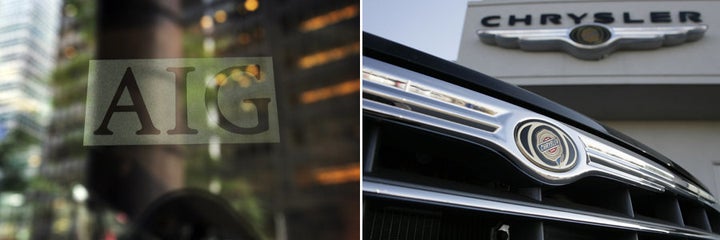
The White House, auto executives and union representatives were all able to come to an agreement last week to keep Chrysler out of bankruptcy. But the car company's creditors -- Wall Street banks and hedge funds -- refused repeated compromises and drove the company under.
The refusal doomed a major American auto company to bankruptcy, but it may have been a smart business move for the lenders.
Many of the Wall Street firms holding Chrysler bonds may also own credit default swaps that they bought to hedge their bets. These swaps, which are essentially like an insurance policy on the bonds should Chrysler default, were likely mostly issued by AIG.
AIG, thanks to the government bailout, has paid off swaps in the past at 100 cents on the dollar. Under the deal they would have had to accept with Chrysler, the bondholders would have received as little as 30 cents on the dollar, for example.
Why take 30 or 35 cents on the dollar from Chrysler when you can get the whole buck from the American taxpayer?
"The basic story is very simple," says economist Dean Baker of the liberal-leaning Center for Economic and Policy Research. "If they hold credit default swaps on the bonds, they're totally happy with them defaulting."
In what would rank as one of the great scams of this financial crisis, government bailouts may be colliding. Wall Street may be raking in taxpayer dollars through AIG and returning the favor by driving the auto industry into bankruptcy.
Are they? Rep. Elijah Cummings (D-Md.), who has been closely tracking the AIG bailout, wants to find out.
Last week, he met with Neal Barofsky, special inspector general for the Troubled Assets Relief Program (TARP), and asked him to look into it. Barofsky was intrigued.
"He seemed open to looking into the bondholder issue when we met last week, and I am hopeful that he will be able to shed some light on this issue if he deems it worthwhile," says Cummings.
He followed up with a letter to Barofsky on Tuesday, outlining his concerns and formally requesting an investigation.
"While differing accounts exist as to how the actual negotiations played out, the fact remains that Chrysler was not able to reach an agreement with its creditors to the $6.9 billion," writes Cummings. "As an issuer of credit default swaps, it is plausible that AIG had issued swaps on the debt of the American auto companies. We know that the collateral calls and threat of payouts triggered by an AIG bankruptcy forced the federal government to commit up to $182.5 billion to the insurance giant. We also know that many holders of AIG credit default swaps were apparently compensated at 100 percent of par value in order to retire the swaps they held and enable the purchase of the underlying securities (the counterparty payments). Finally, the recipients of the counterparty payments in some cases were the same firms that held auto industry debt."
He goes on: "These circumstances could create tremendous potential for abuse of government assistance to AIG. Knowing that AIG swap counterparties have previously been paid with government funds without being compelled to take any discount or "haircut", if auto creditors had purchased swaps on their debt, they may have had a perverse incentive to allow Chrysler to fail. By not negotiating down the claims or accepting a debt-for-equity arrangement, the auto creditors could collect any credit default swap payments triggered by a Chrysler bankruptcy. Essentially, these creditors could stand to potentially benefit more from a Chrysler bankruptcy than from a restructuring out of court."
If the creditors negotiated a settlement outside of bankruptcy, the swap payoff becomes ambiguous, "but it's much clearer if you're in bankruptcy," says Baker.
Instead of negotiating against itself, the White House could have told creditors that AIG wouldn't be honoring Chrysler swaps in bankruptcy, says Baker. Of course, the creditors could sue AIG to recover the money. But without further taxpayer injections into AIG, even by winning in court the creditors would find very little blood to squeeze out of that dying turnip.
Cummings has five questions for Barofsky to look into:
1. Did AIG issue credit default swaps on debt securities of automobile companies?
2. Did creditors to GM or Chrysler hold credit default swaps on the debt? If so, were these AIG-issued swaps?
3. How many creditors to the auto companies also received payments as AIG counterparties?
4. What obligations are owed by the swap issuers to the holders of auto debt in the event of a bankruptcy or other default event?
5. What was the extent of the potential for abuse of taxpayer funds based on the scenario laid out above?
Read the whole letter:
May 5, 2009
The Honorable Neil M. Barofsky
Office of the Special Inspector General for the
Troubled Assets Relief Program
1500 Pennsylvania Avenue, NW, Suite 1064
Washington, DC 20220
Dear Inspector General Barofsky:
Thank you for your work investigating the American International Group, Inc. (AIG) counterparty payments. I appreciate the update you provided me on this audit on April 28.
As we discussed, I am also concerned by the circumstances surrounding the current efforts to resuscitate the American automobile industry. The Department of the Treasury and the Federal Reserve have provided billions of dollars in working capital for General Motors (GM) and Chrysler LLC (Chrysler) while the two firms pursue financial restructuring solutions. While the assistance to Chrysler terminated at the end of April, GM has approximately three weeks left to complete its restructuring before the working capital ends.
The Chrysler situation was particularly troubling. The company had some $10 billion in outstanding debt that was due to the United Auto Workers Retiree Health Plan. Chrysler and the union were able to negotiate an agreement that modified worker contracts and gave the union an equity position in the restructured auto company.
However, in addition to the contributions owed to the union health plan, Chrysler also carried additional debt in the amount of $6.9 billion. Creditors included JPMorgan Chase & Co., The Goldman Sachs Group Inc., Citigroup Inc., Morgan Stanley, and several smaller banks and hedge funds. Perella Weinberg Partners, Oppenheimer and Stairway Capital Management have been identified thus far as hedge fund creditors.
As you are well aware, Chrysler recently filed for Chapter 11 bankruptcy protection, though a deal is ostensibly in place to merge Chrysler with the Italian automaker Fiat SpA, pending court approval. Until the filing occurred, eleventh hour hopes persisted that Chrysler could reach an agreement with the creditors that provided the $6.9 billion. While differing accounts exist as to how the actual negotiations played out, the fact remains that Chrysler was not able to reach an agreement with its creditors to the $6.9 billion.
As an issuer of credit default swaps, it is plausible that AIG had issued swaps on the debt of the American auto companies. We know that the collateral calls and threat of payouts triggered by an AIG bankruptcy forced the federal government to commit up to $182.5 billion to the insurance giant. We also know that many holders of AIG credit default swaps were apparently compensated at 100 percent of par value in order to retire the swaps they held and enable the purchase of the underlying securities (the counterparty payments). Finally, the recipients of the counterparty payments in some cases were the same firms that held auto industry debt. The Wall Street Journal ran a story on April 30, 2009 detailing the objections identified by some creditors:
Bank-debt holders, many of them hedge funds or distressed debt funds, voted against the latest deal for various reasons, ranging from financial interests to philosophical ones. Some said their funds had bigger positions in Ford Motor Co. or General Motors Corp. and could benefit by a Chrysler bankruptcy and the production capacity that may eliminate. Some funds may also have credit-default swaps on Chrysler bank debt that pay out in the event of a bankruptcy[1].
These circumstances could create tremendous potential for abuse of government assistance to AIG. Knowing that AIG swap counterparties have previously been paid with government funds without being compelled to take any discount or "haircut", if auto creditors had purchased swaps on their debt, they may have had a perverse incentive to allow Chrysler to fail. By not negotiating down the claims or accepting a debt-for-equity arrangement, the auto creditors could collect any credit default swap payments triggered by a Chrysler bankruptcy. Essentially, these creditors could stand to potentially benefit more from a Chrysler bankruptcy than from a restructuring out of court.
While the issues were described in the context of the Chrysler bankruptcy, I believe that potential conflicts could have existed regarding the debt of each Chrysler and GM. Accordingly, I respectfully request that you address the following questions:
1. Did AIG issue credit default swaps on debt securities of automobile companies?
2. Did creditors to GM or Chrysler hold credit default swaps on the debt? If so, were these AIG-issued swaps?
3. How many creditors to the auto companies also received payments as AIG counterparties?
4. What obligations are owed by the swap issuers to the holders of auto debt in the event of a bankruptcy or other default event?
5. What was the extent of the potential for abuse of taxpayer funds based on the scenario laid out above?Thank you for your continued advocacy on behalf of the American taxpayers and for your examination of these issues. Please contact Martin Levine in my office...with any questions.
Sincerely,Elijah E. Cummings
Member of Congress
Ryan Grim is the author of the forthcoming book This Is Your Country On Drugs: The Secret History of Getting High in America
